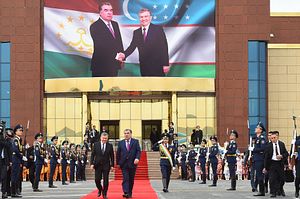In mid-November, the Asian Development Bank (ADB) approved a $35 million grant to reconnect Tajikistan’s electricity system to the once-unified Central Asian power grid via Uzbekistan.
The ADB’s announcement came only a few days before Tajik President Emomali Rahmon, to ostentatious fanfare, marked the start-up of operations at the Rogun dam. At present, the Rogun dam stands only 75 meters tall, with only one of six intended turbines churning. But the dam is designed to reach a record-breaking 335 meters, and should double Tajikistan’s generation capacity once completed. Tajikistan says the dam is scheduled to be completed by 2028. There are serious hurdles to meeting that deadline, the most prominent of which is funding as the dam is estimated to come with a price tag of $3.9 billion.
The ADB project — rather unimaginatively titled the “Reconnection to the Central Asian Power System Project” — builds on two years of diplomatic rapprochement between Tajikistan and Uzbekistan. In that rapprochement, energy has taken center stage just as it featured as a past source of tension.
The Central Asian Power System (CAPS), dates to the Soviet era and managed energy between the republics at the regional level. Tajikistan and Kyrgyzstan were relatively rich in hydropower, though such resources were use primarily for irrigation, with energy generation a secondary focus, whereas Kazakhstan, Turkmenistan, and Uzbekistan were fossil fuel rich.
In a 2015 brief summarizing a study on strengthening CAPS, the World Bank noted that “the end of the Soviet Union resulted in a progressive decline in a crucial function of CAPS… Each country now undertakes energy decision-making independently, eroding established practices (including the physical and technical parameters of the infrastructure).”
In the ADB’s announcement this month, the bank notes that Soviet-era energy infrastructure systems in Tajikistan have “neither been properly maintained nor replaced, especially during the civil war. This significantly deteriorated the reliability of the protection systems, which is one of the key elements for the parallel operation of the power systems.”
The ADB mentions that Tajikistan has not been connected to CAPS since 2009, but in typical development bank style doesn’t mention the very political, and important reasons why.
In 2009, in one account, under the weight of a harsh winter, Dushanbe overdrew from the unified grid, triggering a failure that tossed not only Tajikistan but southern Uzbekistan into frigid darkness. In November 2009, Kazakhstan accused Tajikistan of stealing from the grid, a charge Dushanbe denied.
Uzbekistan, led by cantankerous Islam Karimov, announced its withdrawal from the regional power grid in December 2009, effectively cutting Tajikistan off from a key supplier of winter electricity: Turkmenistan (which withdrew from the unified grid in 2003 but continued to sell electricity to Tajikistan via Uzbekistan).
As Eurasianet noted in summer 2017 as talk of reviving the unified grid warmed up in Tajikistan under the light of Uzbek President Shavkat Mirziyoyev’s good neighbor initiatives:
The reasons for why the unified energy system collapsed are, in fact, even more complicated and knotty than this potted history suggests. But at the heart of the problem is a legacy of distrust among regional leaders, and an aspiration by many of the countries to be fully self-reliant.
The ADB’s project, which will cost $40 million — $35 million as a grant and $5 supplied by the Tajik government — builds on the foundation laid by the resumption of energy trade earlier this year between Tajikistan and Uzbekistan. In February, Tajikistan announced it would begin exporting 1.5 billion kilowatt hours of electricity to Uzbekistan in the summer season. In April, power began to flow.
In technical terms, per the ADB: “Initially, vertically integrated state power utility JSC Barki Tojik will start exporting 1.5 TWh on islanded mode in Uzbekistan (asynchronous operation) and after achieving full parallel operation, the export volume will increase to 5 TWh.”
The ADB project, in turn, is intended to provide the necessary infrastructure to achieve a full parallel operation between Tajikistan and Uzbekistan’s electricity grids, meaning the reconnection of Tajikistan to the wider CAPS via Uzbekistan. Its compoenents include the installation of modern relays, circuit breakers, instrumental transformers, and ancillary equipment and systems at eight 220kV and two 500kV interconnection points; as well as the establishment of two new 500kV interconnections and capacity building for Barki Tojik staff “in reliability of parallel operations.”
The project is slated for completion in 2022.

































